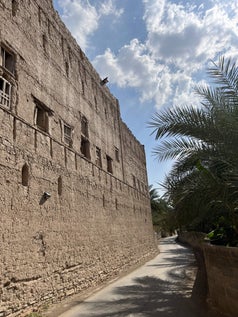Birkat Al Mouz (Mawz), three villages and seven watchtowers, December 2-2021
Birkat Al Mouz brings you back in time. Located on the way to Jebel Akhdar, it is one of the most famous ruin-villages in the Sultanate of Oman. The ancient village consists of two sets of ruin sites, but there must have been a third site. The villages were once home to the tribes who lived in those mountains, such as the The Bani Riyam Tribe, who controlled the Hajar mountain region. The houses are made of gray carbonate rock. The three villages and seven watchtowers are now mostly in ruins, however a few resilient occupants still live in older parts of the village.



Those are not ruins that have been discovered and brought back to the surface. They are just houses that have been abandoned and not maintained.
What happened?
In 1959, following a half-decade long Jabel Ackdar War between the local Imans backed by Saudi Arabia, and Sultan Said bin Taimur, Birkat Al Mouz and several older villages were bombed by the British R.A.F. in support or the Sultan. In Birkat al Mouz, the destruction included the damage and ultimate abandonment of the palace built by the leader of the rebellion, Sheikh Suleyman bin Himyar. fortunately, the bombing was not the end of Birkat Al Mouz. Other villages to the west, such as Tunuf, were not so lucky, the bombs completely destroyed the village. Birkat Al Mouz is not touristic at all, we could just walk into the village and it was just breathtaking. You can just walk around and discover the clay houses with several levels. Look at the details still present such as ornaments, windows, paintings ... it is just so gorgeous! We love these places.

























Falaj irrigation system
Everywhere in the village, you see the irrigation system. This region is known for its abundant water and therefore the existence of all the greeneries, the banana and date farms. The presence of the Falaj irrigation system of Birkat Al Mouz and its position in the Jabel Ackdar region, facilitated the survival of the villages and the farms. Nowadays, there are still some large banana plantations which create a beautiful scenic environment. The old Falaj irrigation system at the at the ruin site is also listed as UNESCO World heritage.









The second village
The views of the mountains and the plantations were inspiring. As you can see below, from there you can see the ruins of the other tribe from Birkat Al Mouz and one watchtower.




